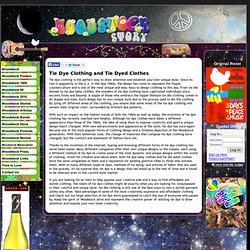

Tie Dye Your Nails! (water marbling) The Art of Tie Dye. Although the era of psychedelia gave tie-dye it's attitude, the trend has roots.

The earliest forms of this art are said to have been around since 500-800 A.D., dyed with pigments from roots, flowers, leaves and berries. In Peru, the technique known as ikat was used in their elaborate weavings. The designs were mostly dots and lines on wool, but as the art form came to be more sophisticated ikat became a way to convey status or wealth. Shibori is a form of tie-dye or “shape resist dyeing” that originated in Japan. Foodista:Tie-Dyed Treats. We’re excited to bring you another great article from LilSugar, a fantastic source for mamas who want advice and news about everything from packing healthy lunches to mastering the art of stroller chic.

This week, we’re featuring their tie-dyed recipes to get toddlers excited about breakfast, lunch and dinner. Tie Dye Cupcakes help Girls Graduate. A World of Resist Dye Techniques. Stager and Blum Galleries | Sara Hume, Curator Cultures around the world have developed an array of resist dye techniques.

Dyeing provides rich colors but once the fabric has been colored in a dark shade, lighter color patterns will not show up. In order to allow lighter colors to come through, areas have to be blocked from receiving dye. Tye Dye Everything - Home. Inspiration. Military Influence on Today's Tie-Dye. Charleston has been a military town since the 18th century.

It is the perfect setting for the TV series Army Wives. Fort Moultrie celebrated its 171 anniversary Saturday with a fashion show MilitaryWife-Military Life: How Did We Get From This to This. It showed clothing from the American Revolution through World War II. Women’s fashion designs have a long history of military influence. Despite military themes in fashion, women were not officially or authorized to serve in the military until 1898 in the Spanish American War, and than only as nurses.
Lauren Topor in her 2008 thesis; Political Views and How Military Styles Influences Fashions wrote “Virtually every factor of the military has been employed in civilian fashion, including epaulets, ball buttons, khaki adapted from the British military in India, and olive drab.” Nicole Miller fashions are available locally at Berlin’s, Copper Penny, and Gwynn’s of Mt. Grateful Dead Dancing Bear's. The grateful dead dancing bears have been around a long time, and have found a permanent spot in the music culture.

The meaning and story behind them is very interesting to the deadhead culture. The Grateful Dead Bears have fourteen different generations. Each of these bears has a special symbolic the event of either a Grateful Dead song or a tribute to a bandmember. All of the generations of bear have become a great symbol to the Grateful Dead scene as well as a hip status of a fun loving sprit. Furthermore, many of these bears have become a great memory of different Grateful Dead tours. Janis Joplin's Impact on Hippy Culture. Singer Janis Joplin rose to fame in the late 1960s and was known for her powerful, blues-inspired vocals.

She died of an accidental drug overdose in 1970. Synopsis Born on January 19, 1943, in Port Arthur, Texas, Janis Joplin developed a love of music at an early age, but her career didn't take off until she joined the band Big Brother and the Holding Company in 1966. Their 1968 album, Cheap Thrills, was a huge hit. However, friction between Joplin and the band prompted her to part ways with Big Brother soon after. Wild Child Janis Lyn Joplin was born on January 19, 1943, in Port Arthur, Texas. Developing a love for music at an early age, Joplin sang in her church choir as a child and showed some promise as a performer.
At Thomas Jefferson High School, Joplin began to rebel. Early Musical Interests Musically, Janis Joplin and her friends gravitated toward blues and jazz, admiring such artists as Lead Belly. Best US Cities to Visit for the Love of Tie-Dye. While some may think all the hippies have burned out or faded away, the truth is they’re still out there, still busily making love, but not war. We here at Estately set out to find communities where they’re heavily concentrated, as well as providing ideal habitat for the next generation of flower children. To determine this we used a formula based on marijuana availability and legality, number of stores selling hemp, local counter-culture icons, tie-dye availability, hippie festivals, progressive government, intensity of Occupy protests, and a Facebook poll. Mary, Voted the best tie dye artist. Artist Pushing the Limits of Dye. Colorful Cotton Cloth Knots.
Home » Fashion » Tie Dye T-Shirts The origins of Tie-dye T-shirts are believed to have begun in Nigeria where women would tie cotton fabrics into knots and then dip them into dyes.

When they untied the knots, they were presented with vivid, colorful cloth patterns. In Japanese society, Tie-Dying was also practiced as kimonos were colored by using thread to restrict areas of cloth much as the Nigerian knots did. The concept behind both methods was to restrict the flows of a dye from reaching certain areas of cloths and this was achieve through the use of knots, thread, rocks, sticks and rubber bands.
The parts that the dye is able to reach will be altered but the restricted part will stay untouched providing a pleasant contract of colors, generally situated right next to each other. RIT Dye Brand is Saved By Tie Dye. Tie-Dye resist techniques have been practiced around the world in many forms for centuries.

There are the Traditional Japanese Shibori, Indian Bandhana, and Indonesian Plangi or Tritik, also the weaving of resist dyed warps and wefts called Ikat. Ancient examples have been found in South America as well. These traditional techniques were known of in the US by the early 1900s but the techniques and fabrics were still very much connected with their regions of origin. Anyone practicing these crafts was carrying on the traditions of their culture. Tie Dye Impacts Fashion Industry. Tie dye clothing is the perfect way to draw attention and establish your own unique style.

Since its rise in popularity in the U.S. in the late 1960s, the design has come to represent the hippie counterculture and is one of the most unique and easy ways to design clothing to this day. From tie die dresses to tie dye baby clothes, the wonders of tie dye clothing have captivated individuals since ancient times and beyond. A staple of those who embrace the hippie lifestyle tie die clothing comes in all shapes and sizes. Each design has its own unique style due to the process used to die the clothing. Ancient Japan & China Introduce Tie-Dye. When we think of tie dye and where it might have originated, the first image that often comes to mind is the freewheeling hippie lifestyle of the 1960′s.

Today, many of us who wear tie dye feel some connection with that peace-loving hippie spirit! You might be surprised to learn that the history of tie dye actually began long before those free-loving, music-grooving Woodstock-era days; the earliest mentions of tie dye in historical records were in ancient Japan and China. In China they were using tie-dye from 618 to 906 C.E., during the T’ang dynasty. In Japan they used tie dye during the Nara period of 552 to 794 C.E. Tie-Dye Comes to America. Ancient Tie-Dye Methods. Tie-dye - China Culture Center. Tie-dye (zha ran 扎染) :As the name shows, the tie-dye process can be divided into two parts, first tie and then dye.
Normally we use strings and wood strips, squares and chopsticks to tie parts of the fabric so that they will not absorb dye, giving the fabric a streaked or mottled look. Tie Dye Through the Ages. Tie-dye as we know it became popular in the United States in the mid-1950's. People used direct dying methods with either "natural" or grocery-store type dyes-- randomly folding, twisting, and tying fabric or clothing . The items were then either dipped or put into a dye bath.
The results were simple and varied designs; but they were not vibrant and tended to fade quickly. Still, everybody loved them!